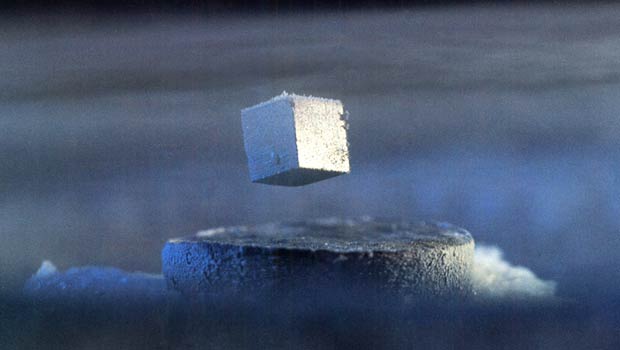Superconductivity or zero electrical resistance at room temperature is any physicist’s dream, but so far the challenges have proven too great. Typically, metals like mercury become superconductive at temperatures close to absolute zero or -273 degrees Celsius. This means that we need to add a lot of energy to refrigerate the material so we might then exploit superconductivity, making the idea unfeasible as of now. Is stable room temperature superconducitivity possible? Just a few weeks ago I’ve written how this state was attained at room temperature, but only for a fleeting moment – just a milionth of a second. What’s clear so far is that we won’t ever be able to reach a stable state until we thoroughly understand what happens inside a superconductive material. Helping in this quest are Swiss scientists at the Ecole Polytechnique Fédérale de Lausanne who found electron spin plays a major role zero electrical resistance.
Look to the spin for the key

High-temperature superconductivity helps scientists measure small magnetic fields, and aids advances in fields including geophysical exploration, medical diagnostics and magnetically levitated transportation. The discovery earned Bednorz and Müller the 1987 Nobel Prize in Physics. Credit: IBM
So far, the most promising superconductors are a class of material called cuprates. These can achieve superconductivity at a much higher temperature – only minus 120 degrees Celsius. Typically, this state is achieve near absolute zero when the electrons of the material join up and form electron couples that are called “Cooper pairs”, and in this form can flow without resistance. In cuprates, Cooper pairs do not form because atoms nudge them together, so clearly they become superconductive under a different mechanism than other materials.
A team of researchers led by Marco Grioni at EPFL has used a cutting-edge spectroscopic technique to explore the unique superconductivity of cuprates. The scientists used a technique called Resonant Inelastic X-ray Scattering, which is used to investigate the electronic structure of materials. This high-resolution method was able to monitor what happens to the electrons of a cuprate sample as it turned into a superconductor.
“Normally, superconductors hate magnetism,” says team leader Marco Grioni. “Either you have a good magnet or a good superconductor, but not both. Cuprates are very different and have really surprised everyone, because they are normally insulators and magnets, but they become superconducting when a few extra electrons are added by gently tweaking its chemical composition.”
Starting in the 1920s, Otto Stern and Walther Gerlach of the University of Hamburg in Germany conducted a series of important atomic beam experiments. Knowing that all moving charges produce magnetic fields, they proposed to measure the magnetic fields produced by the electrons orbiting nuclei in atoms. Much to their surprise, however, the two physicists found that electrons themselves act as if they are spinning very rapidly, producing tiny magnetic fields independent of those from their orbital motions. Soon the terminology ‘spin’ was used to describe this apparent rotation of subatomic particles.
Spin is a bizarre physical quantity. It is analogous to the spin of a planet in that it gives a particle angular momentum and a tiny magnetic field called a magnetic moment. Thus, among other things, electron spin is a key ingredient involved in magnetism. When spins interact with each other, they form spin waves. When magnetic materials are disturbed, spin waves are created and spread in ripples throughout their volume. Such spin waves are telltale fingerprints of the magnetic interaction and structure.
Unlike other materials, cuprates retain their magnetic properties when becoming superconductive.
“Something of the magnet remains in the superconductor, and could play a major role in the appearance of superconductivity ” says Grioni. “The new results give us a better idea of how the spins interact in these fascinating materials.”
Scientists now have a much better picture of what happens inside cuprates, by revealing the role spin interactions have. Eventually, tiny findings like these might couple together so that we might finally come up with a stable room-temperature superconductor, one with the potential to transform forever the electronics industry. Imagine power lines with zero loss or high speed rail that floats on a magnetic quantum cushion. All of these and much more might be possible one day. Here’s to a superconductive future.
Findings appeared in Nature Physics.









